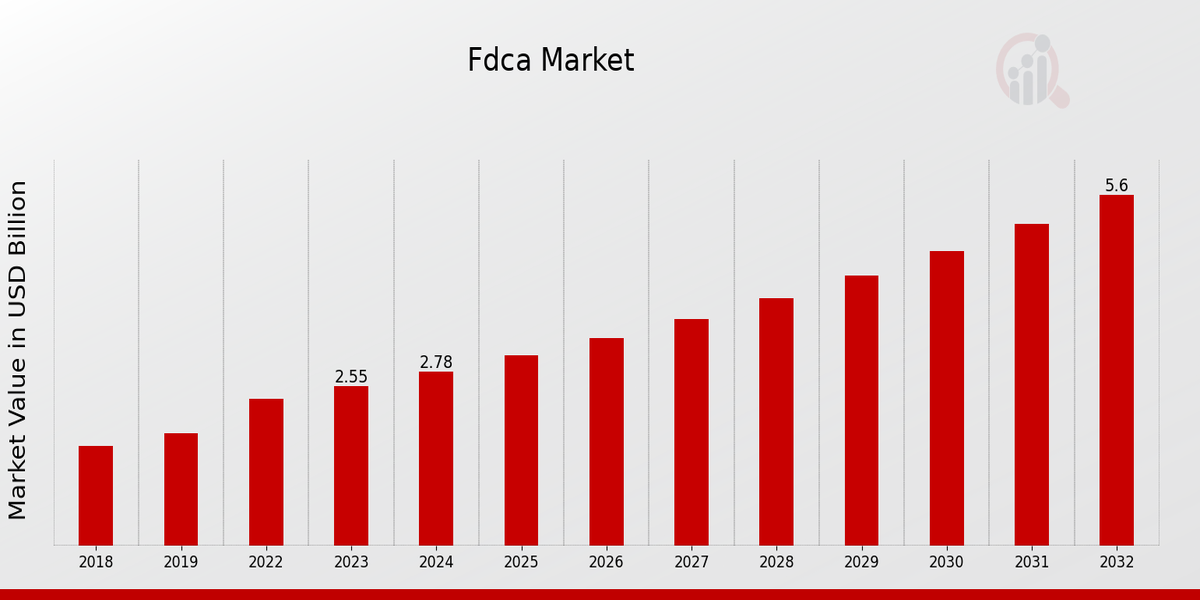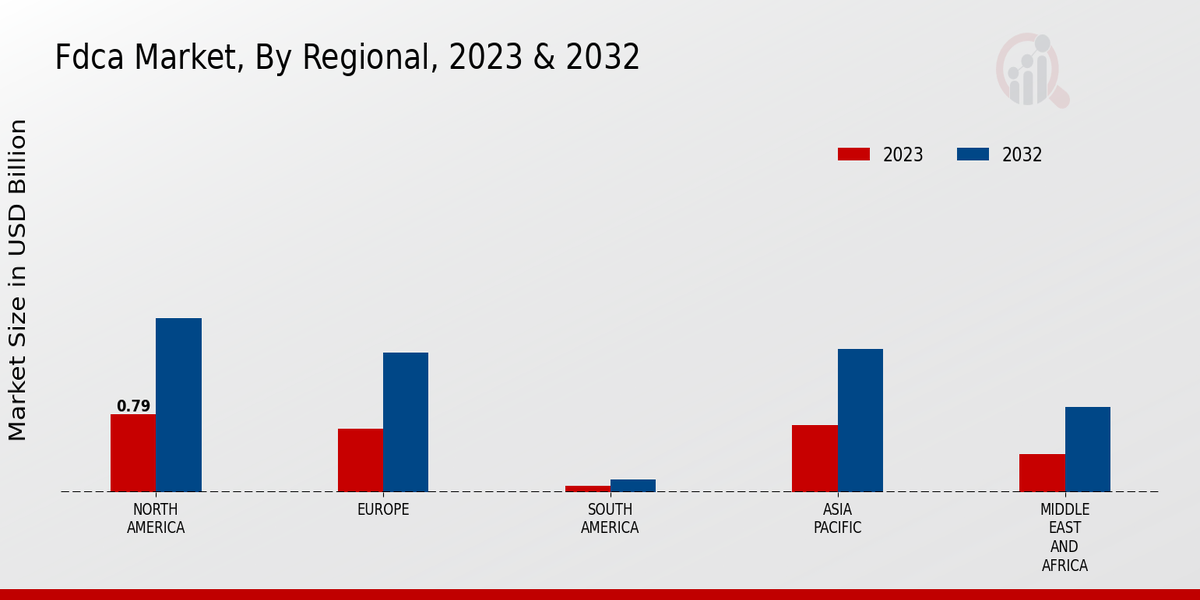Global FDCA Market Overview
The FDCA Market Size was estimated at 3.04 (USD Billion) in 2024. The FDCA Industry is expected to grow from 3.32 (USD Billion) in 2025 to 7.28 (USD Billion) by 2034. The FDCA Market CAGR (growth rate) is expected to be around 9.10% during the forecast period (2025 - 2034).
Key FDCA Market Trends Highlighted
The FDCA Market is poised for significant growth, driven by increasing demand for sustainable and eco-friendly materials.
The growing adoption of FDCA in place of traditional fossil fuel-based polymers such as PET and nylon presents a major opportunity for players in the market.
Moreover, the increasing awareness of the environmental impact of plastics and the drive toward circular economy models are further driving the adoption of FDCA.
Trends in recent times include the development of biodegradable and compostable FDCA-based materials, the integration of FDCA into existing production processes, and the expansion of FDCA applications in various industries, including packaging, automotive, and textiles.

Source: Primary Research, Secondary Research, MRFR Database and Analyst Review
FDCA Market Drivers
-
Increasing Demand for Bio-Based and Sustainable Products
The growing awareness of the environmental impact of traditional plastic products has led to a surge in demand for bio-based and sustainable alternatives.
FDCA, being a plant-based chemical, aligns perfectly with this trend. Its use in the production of bioplastics, biodegradable packaging, and other sustainable applications is expected to propel market growth.
The FDCA Market is witnessing a shift towards eco-friendly and sustainable solutions, and FDCA is poised to play a significant role in meeting this demand.
Growing Adoption in the Automotive and Transportation Sector
Automotive and transportation represent, perhaps, the primary sphere of plastic consumption. The applications of FDCA-based materials are becoming more commonly used.
The benefits arise from the light weight of the polymer, its resistance to chemicals and heat, and its strength, which are of particular importance for the automotive industry.
As modern trends imply the growing emphasis on lighter vehicles and the development of fuel-efficient transportation system stimulate the choice of FDCA in automotive and transportation.
Technological Advancements and Innovations
Continuous improvement in production efficiency and expansion of the application scope of FDCA are the common goals of ongoing research and development efforts.
Better fermentation and extraction technologies are emerging and have affected reductions in costs and increases in scalability.
It is worth noting that new FDCA-based polymers and composites have enabled the materials to be used in industries apart from the variety.
FDCA Market Segment Insights
FDCA Market Product Type Insights
The FDCA Market segmentation by Product Type Bio-based FDCA Fossil-based FDCA In 2023, the Bio-based FDCA segment accounted for the largest share of the FDCA Market revenue, and it is expected to continue to head the market in the upcoming years.
The rise in the segment is determined by the increasing demand for environmentally friendly goods. Fossil-based FDCA is predicted to demonstrate sustainable growth in the period.
The FDCA Market data reveals that the market for Bio-based FDCA will grow faster than that for Fossil-based FDCA owing to the increasing popularity of bio-based goods and the expanding awareness of the danger of using fossil fuels.
According to the FDCA Market Statistics, the market for Bio-based FDCA is predicted to demonstrate a CAGR of 10.5% in the future period and reach a valuation of 2.2 billion USD by 2026.
The Fossil-based FDCA segment will grow at a slower rate of 7.5%, tires and reach 1.5 billion USD by the end of the period.
The FDCA Market is fueled by the increasing demand for FDCA for bio-based plastics production, such as polyethylene furanoate that has better characteristics in comparison with the traditional plastic.
The development of the market is also ensured by the expansion of the demand for FDCA for other bio-based products, such as solvents, detergents, lubricants, etc.

Source: Primary Research, Secondary Research, MRFR Database and Analyst Review
FDCA Market Application Insights
The FDCA Market segmentation by Application is a crucial aspect of market analysis, shedding light on the diverse sectors driving market growth.
Engineering plastics account for a notable share of the market, driven by their exceptional strength and durability, making them ideal for automotive and construction applications.
Bioplastics, derived from renewable resources, are gaining traction due to rising environmental concerns and offer biodegradable and sustainable alternatives. Packaging represents another significant segment, with FDCA-based materials offering improved barrier properties and recyclability.
Pharmaceuticals leverage FDCA for drug delivery systems and medical devices, benefiting from its biocompatibility and controlled release capabilities. Cosmetics applications utilize FDCA for its emollient and skin-conditioning properties, contributing to the segment's growth.
Other emerging applications include electronics, adhesives, and coatings, further expanding the market's potential.
Understanding these application segments and their respective market shares enables key stakeholders to identify growth opportunities and tailor their strategies accordingly, contributing to the overall success of the FDCA Market.
FDCA Market FDCA Source Insights
The FDCA source segment plays a crucial role in shaping the dynamics of the FDCA Market. In 2023, biomass accounted for most of the market revenue, with a significant share of over 60%.
This dominance is attributed to the growing demand for sustainable and eco-friendly materials in various industries.
Fossil fuels, on the other hand, held a substantial share of around 35% in the same year. However, the market data suggests a gradual shift towards biomass as the preferred FDCA source, driven by increasing environmental concerns and government regulations promoting renewable resources.
This trend is expected to continue in the coming years, with biomass projected to capture an even larger share of the FDCA Market by 2032.
FDCA Market Technology Insights
The FDCA Market Segmentation by Technology includes Chemical Recycling, Biological Conversion, and Hybrid Technologies. Chemical Recycling emerged as the leading technology in 2023, accounting for over 60% of the FDCA Market revenue.
The dominance of Chemical Recycling is attributed to its cost-effectiveness and scalability. Biological Conversion technology is projected to gain traction, capturing a notable market share by 2032.
This is driven by growing environmental concerns and advancements in biotechnology. Hybrid Technologies, which combine Chemical Recycling and Biological Conversion, offer the potential for improved efficiency and sustainability.
As a result, they are expected to witness increasing adoption in the coming years. This growth is primarily driven by rising demand for sustainable packaging solutions and increasing investments in bio-based materials.
FDCA Market Regional Insights
Regionally, the market is segmented into North America, Europe, APAC, South America, and MEA. North America is expected to dominate the market in terms of revenue, followed by Europe and APAC.
The growth in North America is attributed to the increasing demand for FDCA in the automotive and construction industries.
Europe is expected to witness a steady growth rate, owing to the growing awareness about the benefits of FDCA in various applications.
APAC is expected to be the fastest growing region, due to the rising demand for FDCA in the packaging and electronics industries.

Source: Primary Research, Secondary Research, MRFR Database and Analyst Review
FDCA Market Key Players and Competitive Insights
Major players in the FDCA Market are constantly striving to develop innovative products and technologies to gain a competitive edge. The FDCA Market is characterized by intense competition, with leading players focusing on strategic partnerships, acquisitions, and mergers to strengthen their market position.
The FDCA Market Competitive Landscape is expected to remain dynamic, influenced by factors such as technological advancements, changing consumer preferences, and regulatory policies.
A leading player in the FDCA Market is BASF, a chemical company headquartered in Germany. BASF is known for its strong portfolio of FDCA-based products and its commitment to sustainability.
The company's research and development efforts are focused on developing innovative solutions for the FDCA industry. BASF's extensive presence and distribution network allows it to cater to a wide range of customers.
A competitor company in the FDCA Market is Arkema, a specialty chemicals company based in France. Arkema has a strong focus on bio-based chemicals and is actively investing in the development of FDCA-based solutions.
The company's R&D efforts are directed towards creating sustainable and high-performance products. Arkema's commitment to innovation and its presence have positioned it as a formidable competitor in the FDCA industry.
Key Companies in the FDCA Market Include
- SABIC
- Mitsubishi Chemical Corporation
- Dow
- Evonik
- LyondellBasell
- TotalEnergies
- BASF
- INEOS
- Borealis
- Eastman
- Kraton Corporation
- Shell
- Westlake Chemical Corporation
- Chevron Phillips Chemical Company
- ExxonMobil
FDCA Market Developments
Recent developments in the FDCA Market highlight the growing demand for bio-based and sustainable materials. The market growth is attributed to rising environmental concerns, increasing adoption of bioplastics, and government regulations promoting sustainable practices.
Key players in the market include BASF, Avantium, and Arkema, who are investing in research and development to enhance production efficiency and expand product offerings.
Technological advancements, such as improved catalysts and fermentation processes, are expected to further drive market growth in the coming years.
FDCA Market Segmentation Insights
FDCA Market Product Type Outlook
- Bio-based FDCA
- Fossil-based FDCA
FDCA Market Application Outlook
- Engineering plastics
- Bioplastics
- Packaging
- Pharmaceuticals
- Cosmetics
- Others
FDCA Market FDCA Source Outlook
FDCA Market Technology Outlook
- Chemical Recycling
- Biological Conversion
- Hybrid Technologies
FDCA Market Regional Outlook
- North America
- Europe
- South America
- Asia-Pacific
- Middle East and Africa
| Report Attribute/Metric |
Details |
| Market Size 2024 |
3.04(USD Billion) |
| Market Size 2025 |
3.32(USD Billion) |
| Market Size 2034 |
7.28(USD Billion) |
| Compound Annual Growth Rate (CAGR) |
9.10% (2025 - 2034) |
| Report Coverage |
Revenue Forecast, Competitive Landscape, Growth Factors, and Trends |
| Base Year |
2024 |
| Market Forecast Period |
2025 - 2034 |
| Historical Data |
2020 - 2024 |
| Market Forecast Units |
USD Billion |
| Key Companies Profiled |
SABIC, Mitsubishi Chemical Corporation, Dow, Evonik, LyondellBasell, TotalEnergies, BASF, INEOS, Borealis, Eastman, Kraton Corporation, Shell, Westlake Chemical Corporation, Chevron Phillips Chemical Company, ExxonMobil |
| Segments Covered |
Product Type, Application, FDCA Source, Technology, Regional |
| Key Market Opportunities |
The growing demand for biobased materials The increasing use in automotive and construction industries Rise of sustainable packaging solutions Expansion into emerging markets Technological advancements in FDCA production |
| Key Market Dynamics |
Rising demand from the packaging sector Increasing adoption in the automotive industry Government regulations on plastic waste reduction |
| Countries Covered |
North America, Europe, APAC, South America, MEA |
Frequently Asked Questions (FAQ) :
The FDCA Market is projected to reach a valuation of approximately USD 3.32 billion in 2025.
The FDCA Market is expected to exhibit a steady Compound Annual Growth Rate (CAGR) of around 9.10% during the period from 2025 to 2034.
The Asia-Pacific region is anticipated to account for a significant share of the FDCA Market revenue due to increasing demand from end-use industries and supportive government regulations.
FDCA finds applications in a diverse range of industries, including packaging, automotive, construction, and consumer products.
Some of the prominent players in the FDCA Market include BASF SE, Mitsubishi Chemical Corporation, and Toray Industries, Inc.
The growth of the FDCA Market is primarily driven by rising environmental concerns, increasing demand for sustainable materials, and advancements in FDCA production technologies.
The FDCA Market may face challenges related to raw material availability, price fluctuations, and competition from alternative materials.
The FDCA Market is projected to reach a valuation of approximately USD 7.28 billion by the year 2034, showcasing a significant increase from its 2025 valuation.
The packaging segment is anticipated to hold a substantial revenue share in the FDCA Market due to the growing demand for sustainable packaging solutions.
The FDCA Market is witnessing a growing trend towards bio-based FDCA production, driven by the need for more sustainable and environmentally friendly processes.

















